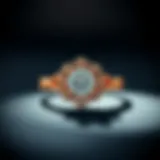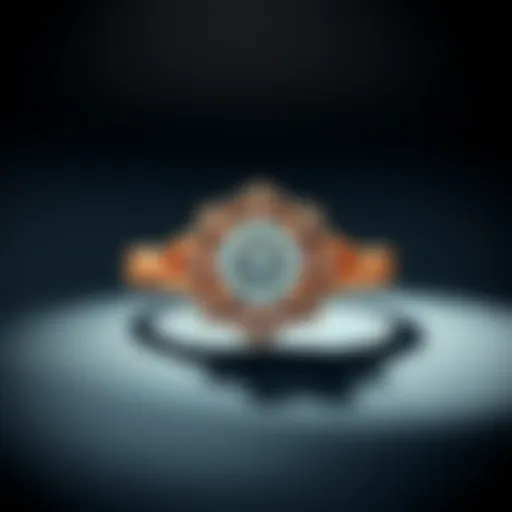Understanding the Allure of 10 Carat Blue Diamond Rings


Intro
10 carat blue diamond rings hold a unique position in the market of fine jewelry. Their vibrant color and substantial carat weight make them a sought-after choice among enthusiasts. This article seeks to unravel the intricate layers surrounding these coveted gemstones. We will explore their geological origins, delve into their market value, and consider the ethical implications of their acquisition. This discussion aims to provide collectors, designers, and gem enthusiasts with a thorough understanding of what makes these rings so alluring.
Gemstone Overview
Description of the gemstone
Blue diamonds are part of a rare class of colored diamonds. Their intense blue hue primarily comes from the presence of boron during their formation deep within the Earth’s crust. Unlike traditional white diamonds, blue diamonds are known for their depth of color, which can range from a light sky blue to a deep, vivid blue. The 10 carat size signifies not just a substantial piece of jewelry but also an item that often carries significant historical importance and luxury.
Physical properties
The physical characteristics of blue diamonds contribute to their value. These diamonds exhibit a hardness of 10 on the Mohs scale, making them one of the hardest materials known. Their toughness and resistance to scratching allow them to retain their beauty over time. Additionally, their refractive index offers incredible brilliance and fire. The unique features include:
- Color Grading: Blue diamonds are graded differently than white ones. The hue can vary in saturation and tone, affecting its value.
- Clarity: Clarity refers to the presence of inclusions or blemishes. Blue diamonds are often more valuable if they have fewer inclusions.
- Cut: The quality of the cut can elevate a diamond’s beauty, impacting how well it reflects light. A well-cut 10 carat blue diamond will display superior brilliance.
"The allure of blue diamonds lies in their rarity and the captivating depth of their color, which resonates with those who covet uniqueness and elegance."
Healing Properties
Metaphysical attributes
Beyond their aesthetic appeal, blue diamonds are often associated with various metaphysical attributes. They are believed to promote calmness and clarity in communication. Wearers often report feeling a stronger connection to their intuition when donning these gemstones. Additionally, blue diamonds are thought to help foster emotional healing and a sense of stability.
Common uses in holistic practices
In holistic practices, blue diamonds are used as tools for meditation and mindfulness, encouraging tranquility. Some practitioners recommend placing blue diamonds in meditation spaces to enhance focus. They can also serve as talismans during significant life events, providing both beauty and a symbolic grounding point.
Foreword to Blue Diamonds
Blue diamonds are not just another representation of elegance and luxury. They hold a special place in the world of gemstones due to their rarity and striking color. In the context of this article, understanding blue diamonds is essential. It sets the groundwork for discussions regarding their value, historical significance, and how these elements converge in 10 carat rings. Collectors and jewelry enthusiasts need this foundation to appreciate fully the allure associated with these gemstones.
Defining Blue Diamonds
Blue diamonds are characterized by their captivating hues and unique origins. Their color results from trace amounts of boron present in the diamond's structure. This impurity affects the light absorption process, leading to their captivating blue tones. These diamonds can vary in shade, from light blue to vivid deep blue, giving them distinct characteristics that appeal to different tastes.
Despite their beauty, blue diamonds are classified as one of the rarest types of diamonds. Their rarity in nature contributes to their desirability and value. The most renowned blue diamond, the Hope Diamond, has captured the attention of scholars and collectors alike. This fascination stems from not only its beauty but also its historical context, revealing the complex narrative of gemstones throughout human history.
Historical Significance
The historical significance of blue diamonds spans from ancient civilizations to modern times. Historical records indicate that these stunning gemstones have been associated with royalty and nobility across cultures. Kings and queens adorned themselves with blue diamonds, believing in their powers of protection and fortune.
Notably, the Hope Diamond, which surfaced in the 17th century, remains a pivotal artifact in the study of gemstones. The stone is surrounded by allure and intrigue due to its storied past, emphasizing the connection between blue diamonds and human history. People have long been captivated by their journeys and the legends they carry.
In modern contexts, blue diamonds symbolize luxury and status. Their enduring appeal is not only due to their physical attributes but also to the emotional and cultural narratives they carry. Understanding this historical aspect is vital for collectors and enthusiasts, as it situates blue diamonds not merely as commodities but as storied items rich with heritage and significance.
Understanding Carat in Gemstones
Understanding carat is crucial when exploring the realm of gemstones, particularly for blue diamonds. The term carat expresses the weight of a gemstone, yet it carries deeper consequences regarding its overall value, desirability, and aesthetic appeal. In the case of blue diamonds, each carat increment can significantly influence perceptions and market dynamics. Higher carat weights often correlate with rarity. Thus, for ring buyers, knowing how carat weight affects their choices aids in making informed investments.
What is a Carat?
A carat is a standardized measure for weight in gemstones. One carat equals 200 milligrams. This unit comes from the seeds of the carob tree, which were historically used to balance precious stones on scales. It is not merely a number; it conveys weight, which translates into size, presence, and gravity of a diamond. For consumers, understanding carat can help in recognizing that a larger carat weight does not always equate to better value if other factors, such as clarity and color, are not accounted for.
Furthermore, the term point divides carats into finer measures. A 1.50 carat diamond is often referred to as 150 points. This terminology adds nuance to purchasing decisions, allowing consumers to assess sizes with precision.
Impact of Carat on Value
The impact of carat on the value of gemstones, particularly blue diamonds, is distinct. In general, the price of diamonds escalates with increased carat weight. A two-carat diamond may be substantially more expensive than two one-carat diamonds, even though the combined weight is the same. This phenomenon arises due to rarity. Large diamonds are scarce, thus creating demand.
Key Considerations:
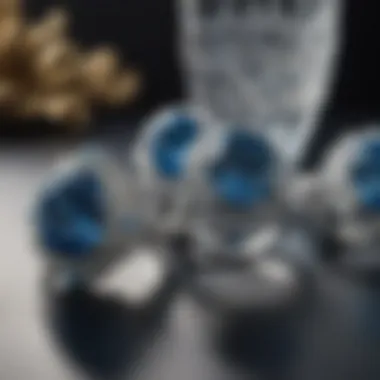

- Rarity: Larger stones are more uncommon, which drives prices up.
- Market Demand: High-profile sales and celebrity endorsements affect consumer interest.
- Proportionality: The value does not increase linearly; the price per carat often climbs exponentially.
"In the world of gemstones, the allure is often in the size, and that size is quantified by carat."
In essence, the carat weight shapes consumer choices and investment strategies within the jewelry market. Buyers must consider their intentions — whether it's for personal enjoyment or as a collectible asset. Each carat can tell a story, representative of one’s taste and appreciation for unique artistry.
Composition of Blue Diamonds
The composition of blue diamonds is not just a matter of technical chemistry; it embodies the essence of why these gems captivate so many. Understanding their composition offers insights into their rarity, value, and appeal. Blue diamonds, primarily made of carbon, acquire their distinctive color from a presence of boron during their formation deep within the Earth. This specific blend creates not only a stunning visual impact but also influences other attributes such as strength and brilliance.
Geological Formation
The geological formation of blue diamonds is a complex process that occurs over millions of years. These diamonds form at depths of about 160 kilometers beneath the Earth's surface in environments characterized by high temperature and pressure. During the convective movement of magma, carbon is subjected to intense conditions which can result in the crystallization of diamonds. The blue hue emerges when boron atoms replace some carbon atoms within the diamond's crystal lattice structure. This incorporation of boron is rare, adding to the overall scarcity of blue diamonds.
"The intense conditions required for the formation of blue diamonds make them some of the rarest gems on Earth."
Rarity defines the allure of blue diamonds. Unlike more common colors found in diamonds, natural blue diamonds are few. Their geological history is unique and intricate, contributing to a fascinating narrative that enriches their desirability.
Unique Coloration Factors
The unique coloration of blue diamonds is affected by several factors that go beyond mere chemical composition. The intensity and uniformity of the color are influenced by the concentration of boron. Natural blue diamonds display a range of colors from pale sky blue to deep, vibrant blue. The most esteemed stones exhibit a rich saturation that is free of secondary hues, thus maximizing their aesthetic appeal.
Several factors contribute to the coloration:
- Boron Content: Higher concentrations of boron lead to deeper blue hues.
- Structural Defects: Internal characteristics can alter how light interacts with the diamond, affecting its overall appearance.
- Cut Quality: A well-cut blue diamond enhances its color and brilliance.
The interplay of these elements underscores why a comprehensive understanding of composition is vital. Following the exploration of geological formation and coloration, one can appreciate not just the beauty of blue diamonds but their intricate and rare origins.
Market Dynamics for Blue Diamonds
Understanding the market dynamics for blue diamonds is crucial for anyone interested in this unique gemstone. The interplay of rarity, availability, and pricing trends determines how these stunning gems are valued in the marketplace. This section provides insight into these factors, aiding enthusiasts and collectors in making informed decisions regarding blue diamonds.
Rarity and Availability
Blue diamonds are one of the rarest types of diamonds available today. Their formation is linked to specific geological conditions, making them not only precious but also scarce. The source of these diamonds is primarily from mines located in South Africa, Australia, and recently, some discoveries in Russia. Such limited sources mean that the availability of these diamonds can significantly constrain the market.
Moreover, unlike more common diamond colors, blue diamonds are less abundant. This rarity contributes greatly to their allure, attracting collectors and gemstone enthusiasts. People often are willing to pay a premium for these stones, driving demand in the luxury market.
"The combination of rarity and an increasing desire for unique jewelry secures a prominent position for blue diamonds in the luxury market."
This charm, paired with the notion that blue diamonds symbolize wealth and sophistication, makes them a sought-after item. In addition, synthetic blue diamonds, though present, do not fulfill the same market demand, as collectors usually prefer the authenticity of natural stones.
Pricing Trends
Pricing of blue diamonds is a complex matter. A variety of elements influence their market value, including carat weight, cut quality, clarity, and color intensity. Blue diamonds with deeper color saturation tend to command higher prices. For instance, a well-cut, high-clarity blue diamond of 10 carats can become a significant investment, often surpassing the price per carat of other colored diamonds.
Over recent years, the trend has seen increasing prices for blue diamonds, particularly as more focus is placed on ethical sourcing and sustainability in the diamond industry. The interest in responsibly sourced gemstones contributes positively to their overall market perception. Furthermore, as luxury jewelry designs evolve, blue diamonds are often integrated into innovative settings, further enhancing their desirability.
Consequently, potential buyers need to stay informed about market trends to understand when to buy or sell. Keeping track of auction results or consulting with knowledgeable jewelers might provide insights into current valuation trends.
In summary, the market dynamics surrounding blue diamonds are characterized by their rarity, influence on pricing trends, and shifting consumer preferences. This knowledge is essential for anyone considering investing in these elegant gems.
Designing Carat Blue Diamond Rings
Designing a 10 carat blue diamond ring is more than just a creative endeavor. This process involves various important considerations that contribute to the overall aesthetic and value of the piece. The allure of blue diamonds, especially in significant carat weights like 10 carats, calls for meticulous attention to detail. Each design choice impacts the perception and appreciation of the ring.
A key factor in the design process is choosing the setting. The setting not only enhances the beauty of the diamond but also plays a crucial role in showcasing its brilliance. Various settings can be employed, each offering unique benefits:
- Prong Setting: This is the most popular choice for diamond rings. The prongs hold the diamond securely while allowing maximum light to pass through.
- Bezel Setting: This design encircles the diamond completely, providing an extra layer of protection. It is ideal for larger stones like the 10 carat blue diamond as it complements its visual weight.
- Halo Setting: Surrounding the central diamond with smaller stones can enhance the overall sparkle and create an illusion of a larger stone.
Every element of the design should complement the unique characteristics of blue diamonds, particularly their color and clarity. Designers must evaluate the diamond’s depth of color and how it interacts with different metal choices, such as white gold or platinum, which can elevate the diamond's striking hue.
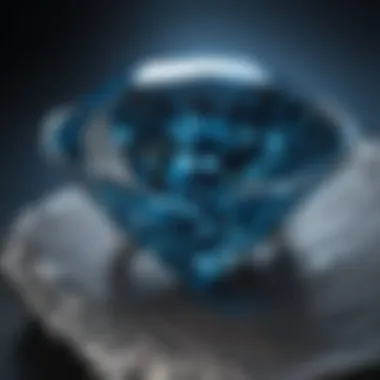

When crafting a 10 carat blue diamond ring, the design must balance elegance with practicality. The weight of the stone influences how the ring sits on the finger. Circulation of air and light around the diamond needs to be considered to maximize its beauty.
Popular Settings
The choice of setting is pivotal in the design of a 10 carat blue diamond ring. Different settings not only highlight the gemstone’s brilliance but also offer varying degrees of protection. Each type of setting serves distinct aesthetics and practical purposes:
- Solitaire Setting: Showcases the diamond as the sole focus, emphasizing its size and color richness. Ideal for a classic look.
- Three-Stone Setting: Symbolizes the past, present, and future, making it a thoughtful choice for significant milestones.
- Channel Setting: Rows of smaller diamonds nestled within metal channels can beautifully accompany the larger blue diamond.
- Tension Setting: Holds the diamond in place with tension, allowing light to pass through the stone from all sides, highlighting its unique color depth.
Choosing the right setting also depends on personal style and lifestyle. For instance, a more secure setting may be necessary for someone with an active lifestyle, ensuring the diamond remains safely in place.
Synergy with Other Gemstones
In designing a 10 carat blue diamond ring, many find charm in synergy with other gemstones. Combining the blue diamond with complementary stones can create a more vibrant and dynamic piece.
- White Diamonds: Pairing with smaller white diamonds can enhance the visual impact, adding sparkle to the design.
- Sapphires: Incorporating sapphires can create a sophisticated palette and extend the blue theme.
- Emeralds or Rubies: These stones offer a striking contrast and may appeal to those looking for a unique touch.
Designing with other gemstones involves understanding their properties, as well as how they interact with the color and clarity of the blue diamond. The goal is to ensure that the additional stones enhance rather than detract from the central focus—a beautiful 10 carat blue diamond. This layered approach in design leads to pieces that are not only visually stunning but also deeply meaningful.
Evaluating the Quality of Blue Diamonds
Evaluating the quality of blue diamonds is crucial for anyone interested in purchasing or appreciating these exquisite stones. A deeper understanding of this topic not only assists potential buyers but also helps collectors and enthusiasts discern value and authenticity. In the realm of gemstones, quality determines not only market price but also potential for appreciation over time. Thus, thorough knowledge in this area can yield significant benefits.
Cut, Clarity, and Color
Cut, clarity, and color are three primary components that influence the overall quality of a blue diamond. Each element holds unique significance and warrants careful examination.
- Cut: The cut refers to the quality of the diamond's proportions, symmetry, and polish. A well-cut blue diamond can reflect light beautifully, showcasing its vivid color and brilliance. Poorly cut diamonds may appear dull or lifeless despite their inherent qualities. Therefore, the cut should be among the first aspects evaluated.
- Clarity: Clarity denotes the presence of inclusions or blemishes within the diamond. The fewer these imperfections, the higher the clarity grade. Blue diamonds are typically evaluated with a magnifying gem lens to assess clarity. GIA, a leading gemological institute, categorizes clarity on a scale from Flawless to Included. Higher clarity grades often result in greater desirability and value in the market.
- Color: The color of blue diamonds varies from light blue to deep blue, with the latter being more sought after. Various grading systems exist, with intensity and hue playing essential roles in determining color quality. According to GIA, color saturation is pivotal, as even slight differences can influence value significantly. Hence, understanding the nuances of color can guide a buyer in making informed decisions.
Certification and Grading
Certification and grading are vital for ensuring the authenticity and quality of blue diamonds. Buying unverified gems can lead to disappointment, both in terms of investment and aesthetic appeal. Reliable grading bodies, like the Gemological Institute of America (GIA), provide documented assessments of a diamond's characteristics.
The certification process examines various factors. This not only includes cut, clarity, and color but also carat weight and overall characteristics. A credible certificate is crucial when buying blue diamonds. It often includes detailed information, helping buyers comprehend the specifics of what they are purchasing.
Another aspect of certification is the grading scale. Understanding this scale can be overwhelming, but it is essential for potential buyers. Relying on ratings from established institutions brings peace of mind and confidence in a transaction. Additionally, certified diamonds often command higher prices because purchasers trust their quality, which may affect resale value.
"Investing in a certified blue diamond guarantees not just authenticity, but it also provides assurance of quality based on strict industry standards."
Cultural Relevance of Blue Diamonds
The significance of blue diamonds extends far beyond their breathtaking visual appeal. In many societies, these gemstones have become symbols imbued with deep meaning and are associated with various cultural beliefs and practices. Understanding the cultural relevance of blue diamonds, especially those weighing around 10 carats, illuminates their status not only as a luxury but also as objects of deep significance that transcend mere aesthetics.
Symbolism Across Cultures
Blue diamonds have been recognized in multiple cultures for their rarity and profound symbolism. In ancient Egypt, blue gemstones were thought to offer protection, representing the heavens and truth. This symbolic link continues today; many cultures associate the color blue with calmness, stability, and faithfulness.
In Western culture, blue diamonds are often seen as a representation of eternal love and commitment. This has made them a popular choice for engagement rings. Celebrities like Elizabeth Taylor and her stunning 33 carat blue diamond ring have shaped public perceptions, solidifying blue diamonds as a symbol of luxury, status, and romance.
- Symbolism in various cultures:
- Ancient Egypt: Protection and connection to the divine.
- Middle Ages: Symbol of nobility and wealth.
- Modern Western Society: Commitment and fidelity.
These meanings enhance the allure of blue diamonds. Individuals who choose a 10 carat blue diamond ring often do so with an understanding of the message they wish to convey, considering not just the visual charm but also the inherent symbolism.
Legacy in Literature and Art
The representation of blue diamonds isn't limited to jewelry. Their legacy permeates literature and art, contributing to their cultural significance. Throughout history, blue gemstones have inspired poets, writers, and artist. For instance, the extravagant imagery often found in literature highlights the preciousness of blue diamonds, symbolizing unattainable beauty or the often painful pursuit of wealth.
In contemporary art, blue diamonds are depicted to comment on themes of opulence and consumerism. This portrayal often serves as social commentary, exploring the dichotomy between beauty and ethical concerns surrounding gemstone acquisition. The exploration of blue diamonds in both classic and current works makes them a recurring motif, hinting at deeper philosophical questions concerning value, both intrinsic and extrinsic.
"A blue diamond is more than just a gemstone; it's a narrative, a living story that holds meaning far beyond its physical presence."
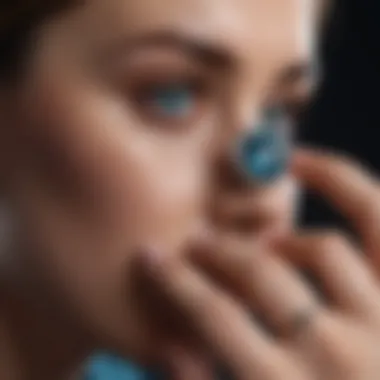

Through various artistic expressions, blue diamonds have woven themselves into the cultural tapestry, emphasizing their importance not only as adornment but as a reflection of societal values and personal aspirations.
Ethical Considerations in Purchasing
In the contemporary jewelry market, ethical considerations play a crucial role in the decision-making process of purchasing blue diamonds. This aspect goes beyond consumer products and delves into the moral implications embedded within the gem trading industry. Understanding these ethical considerations can enhance the overall experience when selecting a 10 carat blue diamond ring. It ensures that the stones not only hold aesthetic and monetary value but also align with one’s values.
Conflict Diamonds
The term "conflict diamonds" refers to stones that are mined in war zones and sold to finance armed conflict against governments. This issue raised global awareness and prompted the establishment of the Kimberley Process in 2003, aimed at regulating the trade of natural diamonds. Many gemstone buyers now take into account the origins of their gems to steer clear of ethical quandaries surrounding conflict diamonds.
When purchasing a blue diamond, it is prudent to demand transparency about the diamond's provenance. Verify if the seller adheres to ethical sourcing guidelines. Reputable jewelers provide provenance information, ensuring that the diamonds have been mined legally and ethically. This not only roots out the association of violence with the jewel but also supports fair labor practices in the mining sector.
"Informed consumers shape the market. By supporting ethical sourcing, they contribute to significant change in the diamond industry."
Some key points to consider regarding conflict diamonds include:
- Research Dealers: Thoroughly investigate your retailer to ensure they practice responsible sourcing.
- Ask for Certification: Request documentation that certifies the diamond's ethical origins.
- Consider Alternatives: Lab-grown diamonds present a conflict-free option worth considering for conscious consumers.
Sustainable Practices
With the increasing awareness of environmental issues, sustainable practices in gemstone sourcing have gained momentum. This involves ecological responsibility in diamond mining operations. Sustainable practices minimize ecological damage and promote the welfare of surrounding communities. Jewelers are increasingly adopting sustainable practices to meet the rising demand for ethically sourced jewels.
When selecting a 10 carat blue diamond ring, look for jewelers committed to sustainability. Many now use eco-friendly mining techniques, ensuring minimal harm to the environment.
Factors associated with sustainable practices include:
- Eco-Friendly Mining Techniques: Utilizing methods that reduce soil and water contamination.
- Community Engagement: Ensuring that local communities benefit from mining operations, both economically and socially.
- Recycling Practices: Some businesses focus on repurposing old diamonds, promoting wearability without further mining.
Care and Maintenance of Blue Diamond Rings
Taking care of 10 carat blue diamond rings is crucial for preserving their beauty and integrity. These exquisite gemstones represent a significant investment, and appropriate maintenance can ensure that they remain in pristine condition for generations. Regular care not only enhances their visual appeal but also helps to maintain their value over time. Knowledge about effective cleaning techniques and proper storage can make a notable difference in ensuring these pieces remain stunning and functional.
Cleaning Techniques
Proper cleaning is fundamental in maintaining the brilliance of blue diamond rings. Here are some recommended methods:
- Mild Soap and Water Solution: Use a mixture of warm water and a few drops of mild dish soap. Soak the ring for about 15-20 minutes. After soaking, gently scrub the ring with a soft-bristle toothbrush, paying special attention to the setting where dirt may accumulate.
- Ultrasonic Cleaners: These devices can be effective for deep cleaning. However, caution is advised as certain settings might loosen or damage the stone. Always consult with a jeweler before using such devices on your blue diamond ring.
- Professional Cleaning: Consider having the ring professionally cleaned at least once a year. Jewelers can offer specialized care tailored for high-value gemstones. They can also check for any loose settings that might need to be tightened.
"Regular cleaning not only enhances the beauty of blue diamonds but also helps identify any issues before they become serious problems."
Avoid using harsh chemicals or abrasive cloths, as they can scratch or damage both the diamond and the metal settings.
Storage Recommendations
Proper storage is equally important for preserving the beauty and condition of blue diamond rings. Here are some effective storage tips:
- Separate Jewelry Storage: Store blue diamond rings separately from other jewelry. This prevents scratches that can occur from contact with harder materials.
- Use Soft Cloths or Pouches: Wrap the rings in soft cloths or place them in fabric-lined pouches. This minimizes exposure to dust and potential scratches.
- Avoid Humidity: Store the rings in a cool, dry place, avoiding areas with high humidity. Humidity can affect metal settings and potentially lead to tarnishing.
- Consider a Safe: If you own multiple valuable pieces, consider investing in a safe. This ensures added protection against theft or accidental damage.
Future Trends in Blue Diamonds
The landscape of blue diamonds is ever-evolving, with emerging trends shaping the market and consumer preferences. The future trends in blue diamonds reflect broader shifts in technology, sustainability practices, and consumer awareness, making it a crucial topic in this article. Understanding these trends provides valuable insights for gemstone enthusiasts, collectors, and jewelry designers, revealing the complexities that govern the allure of these gemstones.
Technological Innovations in Gemstone Processing
Recent advancements in technology have transformed the way blue diamonds are processed and marketed. Innovations in gemstone extraction and manufacturing techniques have improved efficiency and ethical practices in diamond sourcing. For example, advancements in laser cutting technology have made it possible to achieve more precise cuts, enhancing the light performance of blue diamonds.
Moreover, enhanced methods of detecting natural versus synthetic diamonds have reinforced consumer confidence. Tools like spectroscopy and advanced imaging techniques provide valuable information about a diamond's origin, crucial for buyers who value authenticity. As technology continues to progress, it will likely lead to better quality and more accessible blue diamonds for consumers.
"Technological advancements are reshaping consumer perception and trust in the diamond market, crucial for the allure of blue diamonds."
Shift in Consumer Preferences
Consumer preferences have also shifted significantly in recent years, with a growing emphasis on sustainability and ethical sourcing. Buyers are becoming increasingly mindful of the origins of their diamonds. As a result, the market for ethically sourced blue diamonds is on the rise, with consumers favoring brands that demonstrate transparency about their sourcing practices.
This shift towards more responsible purchasing aligns with a broader trend in luxury goods, where individuals are increasingly seeking products that reflect their values. Additionally, there is a notable interest in customized designs that cater to personal styles, further influencing the demand for unique blue diamond rings.
The combination of technological innovation and changing consumer preferences indicates that the market for blue diamonds will continue to evolve. As new trends emerge, the allure of 10 carat blue diamond rings will likely persist, captivating one generation after another.


